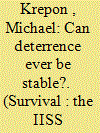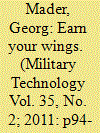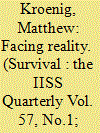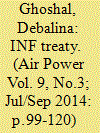| Srl | Item |
| 1 |
ID:
139037


|
|
|
|
|
| Summary/Abstract |
Stability has been the holy grail of deterrence strategists since the outset of the US–Soviet nuclear-arms competition. This prize has been elusive because nuclear weapons are not stabilising. The bomb has had limited, but important, utility in preventing large-scale conventional war, and by fostering cautious behaviour in severe crises.
|
|
|
|
|
|
|
|
|
|
|
|
|
|
|
|
| 2 |
ID:
102261


|
|
|
| 3 |
ID:
138790


|
|
|
|
|
| Summary/Abstract |
Russia’s annexation of Crimea, invasion of Donbas, and continued threats to Ukraine and other European countries not only menace the stability of the post-Cold War order in Europe, but also pose a fundamental challenge to the assumptions about the strategic environment that have undergirded the NATO alliance for the past quarter of a century.
|
|
|
|
|
|
|
|
|
|
|
|
|
|
|
|
| 4 |
ID:
137828


|
|
|
|
|
| Summary/Abstract |
Post the Cuban missile crisis, the arms race started to be viewed as a “necessary evil.”1 A predominant feature of the US-Soviet relationship comprised the efforts made by the two superpowers to indulge in nuclear arms reduction for strategic stability. The Intermediate Range Nuclear Forces (INF) Treaty was one such effort of the arms control measures. On December 8, 1987 President Reagan and General Secretary Gorbachev signed the treaty and agreed to a ‘double global zero’ in which both short range and intermediate range missiles would be eliminated.2 This paper aims to study the background of the treaty by briefly tracing the reasons for the signing of the treaty, the obligations of the treaty, the successes of the treaty, its limitations, and the implications of withdrawing from the treaty.
|
|
|
|
|
|
|
|
|
|
|
|
|
|
|
|
| 5 |
ID:
084283


|
|
|